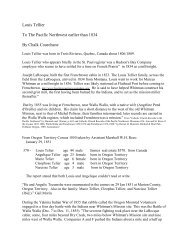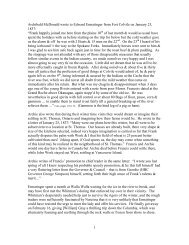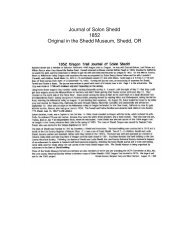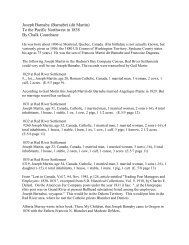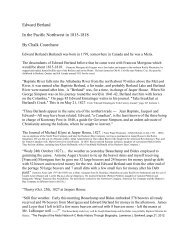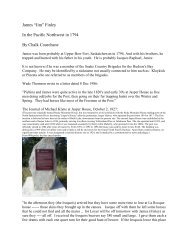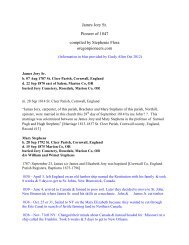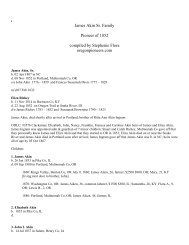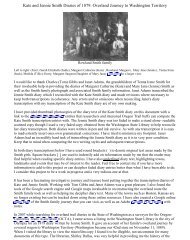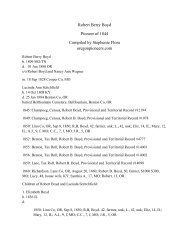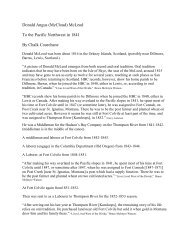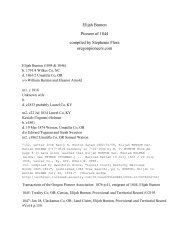(334) Ref: Biology – Wikipedia, <strong>the</strong> free encyclopedia: Tamarack Larch, or Tamarack, orHackmatack, or American Larch (Larix laricina) is a species o larch native to nor<strong>the</strong>rn North America <strong>and</strong> Canada,from eastern Yukon <strong>and</strong> Inuvik, Northwest Territories, etc.(335) Ref: Biology – Wikipedia, <strong>the</strong> free encyclopedia: “Aralia or Spikenard, is a genus of <strong>the</strong> plant familyAraliaceae, consisting of 68 accepted species of deciduous <strong>and</strong> evergreen trees <strong>and</strong> shrubs, <strong>and</strong> some rhizomatousherbaceous perennials.”(336) Ref: Biology – Wikipedia, <strong>the</strong> free encyclopedia: “Gaul<strong>the</strong>ria is a genus: of aromatic evergreenshrubs.Ref: Gaul<strong>the</strong>ria is a genus of about 170-180 species of shrubs in <strong>the</strong> family Ericaceae. The name memorializes M.Hugues Gauthier of Quebec, a mis-spelt honour bestowed by <strong>the</strong> Sc<strong>and</strong>inavian Pehr Kalm in 1748. These plants arenative to Asia, North <strong>and</strong> South America, <strong>and</strong> Australasia.”(337) Ref: Biology – Wikipedia, <strong>the</strong> free encyclopedia: “Rubus is a large genus of flowering plants in <strong>the</strong>rose family, Roseacea, subfamily Rosoideae. Raspberries, blackberries, <strong>and</strong> dewberries are common, widelydistributed members of <strong>the</strong> genus. Most of <strong>the</strong>se plants have woody stems with prickles like roses; spines, bristles,<strong>and</strong> gl<strong>and</strong>-tipped hairs are also common in <strong>the</strong> genus. The Rubus fruit, sometimes called a bramble fruit, is anaggregate of drupelets.”(338) Ref: Curtis’s botanical magazine, or flower-garden displayed in which….: < Symphoria racemosa>“Symphoria racemosa was first mentioned by Michaux, <strong>and</strong> a figure of it <strong>has</strong> <strong>been</strong> lately published by Messrs.Loddiges <strong>and</strong> Sons in <strong>the</strong>ir Botanical Cabinet, where it is stated, that <strong>the</strong>y first received it in <strong>the</strong> spring of 1818, fromMr. Robert Carr. Descr: A low bush shrub; bark of <strong>the</strong> branches britightsh brown. Leaves opposite, round-ovate witha mucro, mostly quite entire, but on <strong>the</strong> lower part of <strong>the</strong> shrub sometimes irregularly notched, smooth, glaucous.Flowers grow on <strong>the</strong> slender, terminal branches in pairs, at first distant, but toward <strong>the</strong> extremities crowded toge<strong>the</strong>r,supported on very short pedicles, sometimes <strong>the</strong> branch becomes leafy beyond <strong>the</strong> flowers. Calyx superior 5-too<strong>the</strong>d, as it often, if not generally is in S. conglomerate, though described to be 4-too<strong>the</strong>d. Corolla rose-coloured,campanulate; limb 5-cleft, obtuse; faux filled with hairs, below which <strong>the</strong> tube abounds with honey. Stamens 5,inserted at <strong>the</strong> upper part of <strong>the</strong> tube, shorter than <strong>the</strong> corolla with <strong>the</strong> laciniae of which <strong>the</strong>y alternate. Germenovate, with two or three small bractes applied close to its base.”(339) Ref: Salal-Berry – definition of Salal-berry by <strong>the</strong> Free Online….: “The edible fruit of <strong>the</strong>Gaul<strong>the</strong>ria Shallon, an ericaceous shrub found from California northwards. The berries are about <strong>the</strong> size of acommon grape <strong>and</strong> of a dark purple color.”CHAPTER XXI(340) Ref: Biology – Wikipedia, <strong>the</strong> free encyclopedia: is a genus of <strong>the</strong>: pea family: having palmatelycompound leaves &, variously colored blossoms.(341) Ref: Biology – Wikipedia, <strong>the</strong> free encyclopedia: < Ranunculus> “Ranunculus is a large genus of about 400species of plants in <strong>the</strong> Ranunculaceae, which includes <strong>the</strong> buttercups, spearworts, water crowfoots <strong>and</strong> <strong>the</strong> lessercel<strong>and</strong>ine (but not <strong>the</strong> greater
cel<strong>and</strong>ine of <strong>the</strong> poppy family Papaveraceae).”(342) Ref: Biology – Wikipedia, <strong>the</strong> free encyclopedia: < Trillium> “Trillium is a genus of about 40-50 species ofperennial herbaceous flowering plants, native to temperate regions of North America <strong>and</strong> Asia. They used to betreated in <strong>the</strong> family Trilliaceae or Trillium family, a part of <strong>the</strong> Liliales or Lily order. The AGP II treats Trilliaceaeas a synonym of <strong>the</strong> family Melanthiaceae. Common names include trillium, wakerobin, Tri Flower, <strong>and</strong> birthroot.”(343) Ref: Wikipedia, <strong>the</strong> free encyclopedia: are a wild vegetable of <strong>the</strong> mustard family.(344) Ref: Goodyera – Wikipedia, <strong>the</strong> free encyclopedia: “Goodyera are a wide-ranging genus oforchid, one of approximately 800 described Orchidaceae genera within that large <strong>and</strong> diverse family. The genus isnamed after botanist John Goodyear.”(345) Ref: Biology – Wikipedia, <strong>the</strong> free encyclopedia: “The Bird's-nest Orchid, Neottia nidus-avis, is anon – photosyn<strong>the</strong>tic orchid found in shady woodl<strong>and</strong> on basic soils. It is a myco-heterotroph. It obtains its nutrientsfrom a mycorrhizal fungus that is attached to a photosyn<strong>the</strong>tic host plant.”(346) Ref: Biology – Wikipedia, <strong>the</strong> free encyclopedia: < Corallorhiza> “Corallorhiza, <strong>the</strong> coralroot orchids, is agenus of flowers in <strong>the</strong> orchid family. Most species are leafless, relying entirely upon symbiotic fungi within <strong>the</strong>ircoral-shaped roots for sustenance. Because of this dependence on myco-heterotrophy within <strong>the</strong>ir mycorrhizae, <strong>the</strong>ycannot be successfully cultivated.”(347) Ref: Biology – Wikipedia, <strong>the</strong> free encyclopedia: < Compositae> “The Asteraceae or Compositae, <strong>the</strong> aster,daisy, or sunflower family, is <strong>the</strong> second largest family of flowering plants, in terms of number of species.” A familyof dicotyledonous plants – dense heads, many florets.(348) Ref: None found: appears to be a genus <strong>and</strong> species of <strong>the</strong> orchid family.(349) Ref: Exotic botany: consisting of coloured figures, <strong>and</strong> scientific, description, of….: is aflowering plant with carmine colored flowers.(350) Ref: Wikipedia, <strong>the</strong> free encyclopedia: “Paeonia brownii (Brown's Peony or NativePeony), is a herbaceous perennial flowering plant in <strong>the</strong> family Paeoniaceae, native to <strong>the</strong> western United States,growing in dry sagebrush <strong>and</strong> Ponderosa Pine country. Excepting Paeonia californica, which is sometimesconsidered a subspecies, this is <strong>the</strong> only Paeonia native to North America. Found throughout <strong>the</strong> northwesternUnited States, etc.”(351) Ref: Wikipedia, <strong>the</strong> free encyclopedia: < Penstemon> “Penstemon, Beard-tongue, is a large genus of NorthAmerican <strong>and</strong> East Asian plants traditionally placed in <strong>the</strong> Scrophulariaceae family. Due to new genetic research, it<strong>has</strong> now <strong>been</strong> placed in <strong>the</strong> vastly exp<strong>and</strong>ed family Plantaginaceae. They have opposite leaves, partly tube-shaped,<strong>and</strong> two-lipped flowers <strong>and</strong> seed capsules.”
- Page 1 and 2:
Don Ubben has been researching the
- Page 3: Buchanan, of Lexington, Ky., joined
- Page 7 and 8: (32) Edwin Bryant, also makes menti
- Page 9 and 10: On Dec. 23, 1819 Harriet married (2
- Page 11 and 12: William S. Clark left Independence
- Page 13 and 14: Lee Co., VA). James & Hannah moved
- Page 15 and 16: Dorintha Shaunce, was born Feb. 13,
- Page 17 and 18: Chimney Rock is 4,226 feet (1,288 m
- Page 19 and 20: 1870 at Rosebud Indian Reservation,
- Page 21 and 22: with the formula NaHCO3. Sodium bic
- Page 23 and 24: was a matter of pure chance that th
- Page 25 and 26: (141) Ref: Ribes irriguum-Plants Fo
- Page 27 and 28: (153) Ref: Emigrants to Oregon in 1
- Page 29 and 30: southern route into Oregon Territor
- Page 31 and 32: wagons.” William D. had already d
- Page 33 and 34: CHAPTER X(183) William Stokes was b
- Page 35 and 36: York Supreme Court, in 1804 Chief J
- Page 37 and 38: (204) Ref: Brittanica Encyclopedia:
- Page 39 and 40: (214) Ref: The Applegate Trail Inte
- Page 41 and 42: Benjamin born in 1818; died in 1852
- Page 43 and 44: (247) Ref: Latin - Definition and M
- Page 45 and 46: greatest explorers. The maps he dre
- Page 47 and 48: an intelligent gentleman, and is al
- Page 49 and 50: and pioneer in the Oregon Country i
- Page 51 and 52: Scrophulariaceae, but following rec
- Page 53: (323) Ref: Fourth edition of Rev. S
- Page 57 and 58: species, etc.”(362) Ref: Wikipedi



